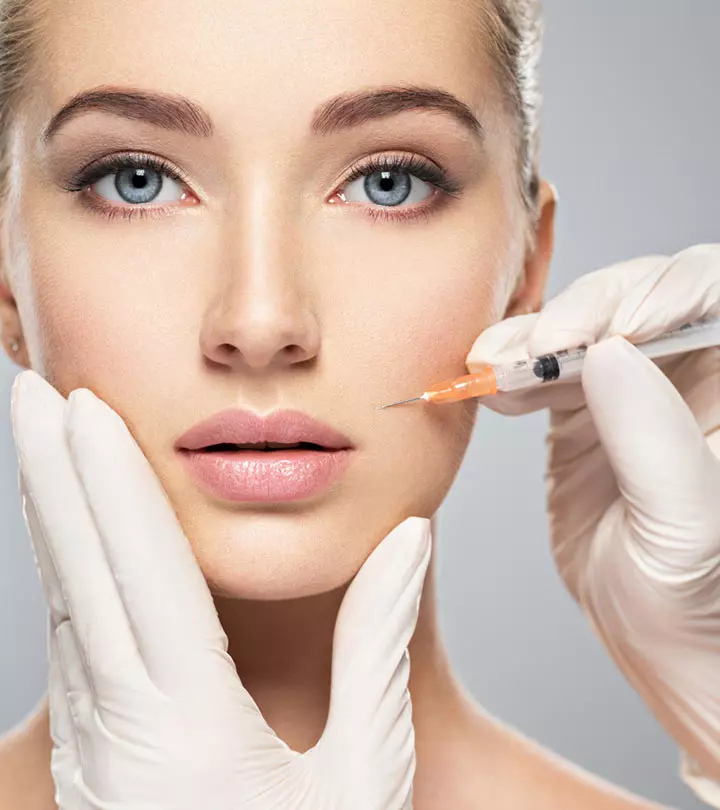Hyaluronic Acid Fillers: Juvederm Guide For Youthful Skin
Injecting HA into your skin can help improve its texture and get fresh, youthful firmness.

Image: Shutterstock
Hyaluronic acid (HA) is an acidic compound used in skin care products. Though it is naturally found in your body, it begins to drain as you age. To compensate for the loss, you can inject hyaluronic acid fillers and maintain the skin’s firmness and youthfulness. It helps restore skin texture and elasticity and reduces the appearance of aging signs. Hyaluronic acid fillers are injected around the mouth, cheeks, under-eye area, and lips. This non-surgical procedure of injecting the compound is called Juvederm.
This procedure aims to restore the youthful appearance of your face by minimizing the appearance of fine lines, facial folds, and wrinkles. A Juvederm treatment can help you attain that much-loved youthful look.
This article can help you clear all your doubts related to the treatment. Keep reading to know more about hyaluronic acid fillers and Juvederm treatment.
In This Article
What Are Hyaluronic Acid Fillers?
Hyaluronic acid fillers, as the name suggests, introduce HA artificially into your skin. Hyaluronic acid has the capacity to hold up to 1000 times its weight in water, which gives a naturally plump and youthful appearance to your skin.
Hyaluronic acid fillers can be injected into any visible part of your face, which includes your cheekbones, temples, lips, chin, jawline, and so on. Different formulas of this product are used according to the requirements of each area. For example, to improve your cheekbones, large-sized particles are used to add apparent volume to your face. On the other hand, smaller particles are used to fill in facial wrinkles and lines.

According to a study conducted with data from the American Society of Plastic Surgery (ASPS), more than 75% of the 3,000,000 minimally invasive cosmetic procedures reported in 2025 involved hyaluronic acid fillers. Since the approval of the first hyaluronic acid-based filler in the US, there has been a significant annual increase in the number of hyaluronic acid filler injections, indicating a growing public interest in these treatments.
The label of the product tells you where it will be injected. Juvederm Voluma is popularly used on the cheeks and chin. Juvederm’s benefits include its ability to provide smooth, natural-looking results with a more prolonged effect duration than other fillers—volvelle on your lips and Ultra Plus and Collude for smile lines.
 Trivia
TriviaLearn all about the benefits of HA fillers in the next section.
Key Takeaways
- Hyaluronic acid fillers introduce HA into your skin artificially.
- They improve skin elasticity and fight the signs of aging.
- Itching, redness, minor pain, lumps, tenderness, swelling, bruising, and bleeding are common side effects of these fillers.
What Are The Benefits Of Hyaluronic Acid Fillers?
The two major benefits of hyaluronic acid fillers are:
- Improve Skin Elasticity: Hyaluronic acid fillers boost collagen production to restore fresh and plum skin and improve its elasticity.
- Fight The Signs Of Aging: Hyaluronic acid fillers reduce the appearance of wrinkles, fine lines, and skin folds. They smoothen out the skin’s texture, and their effect lasts up to a year.
Now, let’s talk about how these fillers work.
How Do Hyaluronic Acid Fillers Work?
A hyaluronic acid filler is injected into your skin. Hyaluronic acid, an active ingredient, is normally produced naturally in your body to enhance collagen production and improve skin texture. It is the deficiency of this acid that a filler compensates.
Hyaluronic acid fillers work by simply boosting the collagen production in your skin to smoothen out the lines and wrinkles and make your skin look plump and youthful.
In this process, the doctor or physician first marks the areas where the hyaluronic acid filler is to be injected. They then inject the filler into your skin and follow it up with a mild massage to ensure uniform distribution and to prevent any swelling. The whole process takes anywhere from 15 minutes to an hour, depending on the size and the physiological complexity of the targeted area. The injections also contain a minor dose of lidocaine that numbs the area to prevent discomfort and pain.
People often get confused between hyaluronic acid fillers and Botox. Learn Botox vs fillers in the next section.
Hyaluronic Acid Fillers Vs. Botox
Both hyaluronic acid fillers and Botox injections fight the signs of aging on your skin. The difference lies in how they work. A hyaluronic acid filler injects a chemical into your skin that your body is supposed to naturally produce to make your skin plump, lustrous, and healthy. Botox, on the other hand, freezes the muscles under your skin in place to smoothen out wrinkles and fine lines and prevent the formation of new ones.
- Botox is for fading dynamic wrinkles that form around the mouth, eyes, and between eyebrows. These wrinkles become more prominent as you age, and Botox helps relax the muscles around the wrinkled areas to prevent any muscle movement that might cause the skin to wrinkle. This process takes a couple of minutes, and the results start showing within two weeks.
- Hyaluronic acid dermal fillers are for reducing wrinkles on facial skin. However, these fillers are not capable of plumping the skin on other body parts, such as breasts. They are only used on soft facial tissues to fade fine lines, smile lines, wrinkles, etc.
Thinking of getting HA fillers? Learn how to prepare for the procedure in the next section.
How To Prepare For Hyaluronic Acid Fillers
First, your dermatologist will examine your medical history thoroughly to ensure you are fit for getting fillers. Listed below are a few things that you need to do in preparation for getting the fillers:
- If you are taking blood thinners like ibuprofen or aspirin, you must stop their intake a week prior to your appointment.
- Stop taking vitamins and other supplements that can affect the procedure and cause blood clotting.
- Eat pineapples from one or two weeks before the treatment as it contains bromelain, an enzyme that can reduce bruising due to procedure.
- Take Arnica, a homeopathic medicine, for 4 to 5 days before the treatment to prevent swelling and speed up healing.
- Stay away from alcohol a week before the treatment.
Find out what to expect during the treatment in the next section.
What To Expect During A Treatment?
Hyaluronic acid filler treatment requires a needle or cannula to administer the dose. This needle or cannula has a blunt tip and, thus, it doesn’t pierce the skin. When the dermatologist uses a cannula, they first use a needle to make an entry point for it.
These fillers are infused with lidocaine to numb the targeted area and reduce pain during the treatment. The whole procedure takes around 15 minutes to half an hour to complete.
Its recovery time is also minimum, but avoid intense exercise, alcohol, sun exposure, and makeup for a minimum of 24 hours after the treatment.
What Are The Potential Side Effects Of Hyaluronic Acid Fillers?
The common side effects of hyaluronic acid fillers are:
- Itching
- Redness
- Minor pain
- Lumps
- Tenderness
- Swelling
- Bruising
- Bleeding
The common side effects subside in one to two weeks.
Some uncommon side effects of hyaluronic acid that may result from inefficiency and mishandling include:
- Allergic reaction
- Inflammation
- Infection
- Numbness
- Cysts and blisters
- Scarring
- Blindness
- Discoloration
- Uneven filler distribution
- Vascular occlusion
- Blindness
 Did You Know?
Did You Know?Now, let’s talk about the cost of this treatment.
How Much Do Hyaluronic Acid Fillers Cost?
The cost of hyaluronic acid fillers varies depending on factors like the number of syringes, the experience of the dermatologist, the location of the clinic, etc. According to 2016 data, the average cost of this treatment is $620 for a single syringe. This cost can also vary depending on the type of filler used, manufacturer, area to be treated, and so on.
Check out the next section to learn how to take care of your skin after getting a filler.
Aftercare
What must you do (and avoid doing) after you receive a hyaluronic acid dermal filler? Here are the basics:
- Drink lots of water and keep yourself hydrated.
- Stay away from alcohol for the next 24 hours.
- Apply an ice pack on the affected area to tame redness and swelling.
- Avoid blood thinners for 3 to 4 days after the treatment as they can cause severe bruising.
Some people are not suitable candidates for hyaluronic acid fillers. Learn all about them in the next section.
Who Is Not The Right Candidate For Hyaluronic Acid Treatment?
If any of the following criteria apply to you, you are advised against getting hyaluronic acid fillers:
- A skin concern or an infection
- Uncontrolled diabetes
- Blood clot issues
- Any severe allergies
- A history of anaphylactic shock
- An allergy to collagen or eggs
- An allergy to animal products
- An allergy to local anesthetics such as lidocaine
- An allergy to bacteria
- Pregnant and breastfeeding individuals
- An allergy to any component that goes into making the filler
Hyaluronic acid fillers are an effective technique to make your skin look younger. The treatment is well-researched, cost-effective, and safe. Depending on the needs of the area to be treated, several formulae of this substance are employed. These fillers smoothen out fine lines and wrinkles by increasing collagen formation in the skin. This includes treatments like under-eye fillers, which can address dark circles and hollows under the eyes. Remember to avoid intense activity, alcohol, sun exposure, and cosmetics for at least 24 hours following the treatment. Though they do carry the danger of a few adverse effects, they are an effective strategy for combating the signs of aging.
Frequently Asked Questions
Is hyaluronic acid filler permanent?
No. Hyaluronic acid filler is not permanent. These are composed of sugar molecules and can dissolve and be excreted by the body in 6 to 18 months.
What is the best hyaluronic acid filler?
Juvederm and Restylane are the most durable and long-lasting dermal fillers.
How painful are hyaluronic acid injections?
While some people may feel pain or swelling after the injection, most may not experience any pain.
Is hyaluronic acid cancerous?
It may interact with specific receptors and promote cell proliferation. This interaction is potentially dangerous in people with cancer (6).
Is hyaluronic acid better than cortisone?
Hyaluronic acid is believed to be more effective and convenient than corticosteroids in terms of offering pain relief (7).
Which is better: collagen or hyaluronic acid?
Collagen is considered a better active ingredient than hyaluronic acid. It can help tighten loose skin and offers a youthful appearance (8).
How can I get hyaluronic acid naturally?
Adding foods such as oranges, kale, bone broth, soy products, almonds, and sweet potatoes to your diet may help increase your intake of hyaluronic acid.
Learn all about hyaluronic acid dermal fillers in the following video. It provides a comprehensive guide to them, helping you get to know about the process. Hit the lay button now!
References
Articles on StyleCraze are backed by verified information from peer-reviewed and academic research papers, reputed organizations, research institutions, and medical associations to ensure accuracy and relevance. Read our editorial policy to learn more.
- Cosmetic Surgery National Data Bank Statistics
https://www.theaestheticsociety.org/ - Perspectives in the selection of hyaluronic acid fillers for facial wrinkles and aging skin
https://www.ncbi.nlm.nih.gov/pmc/articles/PMC2778417/ - Discussion: Juvéderm Volbella with Lidocaine for Lip and Perioral Enhancement: A Prospective, Randomized, Controlled Trial
https://www.ncbi.nlm.nih.gov/pmc/articles/PMC4387144/ - Botulinum toxin (Botox) A for reducing the appearance of facial wrinkles: a literature review of clinical use and pharmacological aspect
https://www.ncbi.nlm.nih.gov/pmc/articles/PMC6489637/ - Dermal Fillers (Soft Tissue Fillers)
https://www.fda.gov/medical-devices/aesthetic-cosmetic-devices/dermal-fillers-soft-tissue-fillers - Caution should be used in long-term treatment with oral compounds of hyaluronic acid in patients with a history of cancer
https://pubmed.ncbi.nlm.nih.gov/26410544/ - Hyaluronic acid compared with corticosteroid injections for the treatment of osteoarthritis of the knee: a randomized control trail
https://www.ncbi.nlm.nih.gov/pmc/articles/PMC4828353/ - Update on Tissue Tightening
https://www.ncbi.nlm.nih.gov/pmc/articles/PMC2922712/
Read full bio of Dr. Anna H. Chacon
Read full bio of Arshiya Syeda
Read full bio of Ramona Sinha
Read full bio of Swathi E




























Community Experiences
Join the conversation and become a part of our empowering community! Share your stories, experiences, and insights to connect with other beauty, lifestyle, and health enthusiasts.